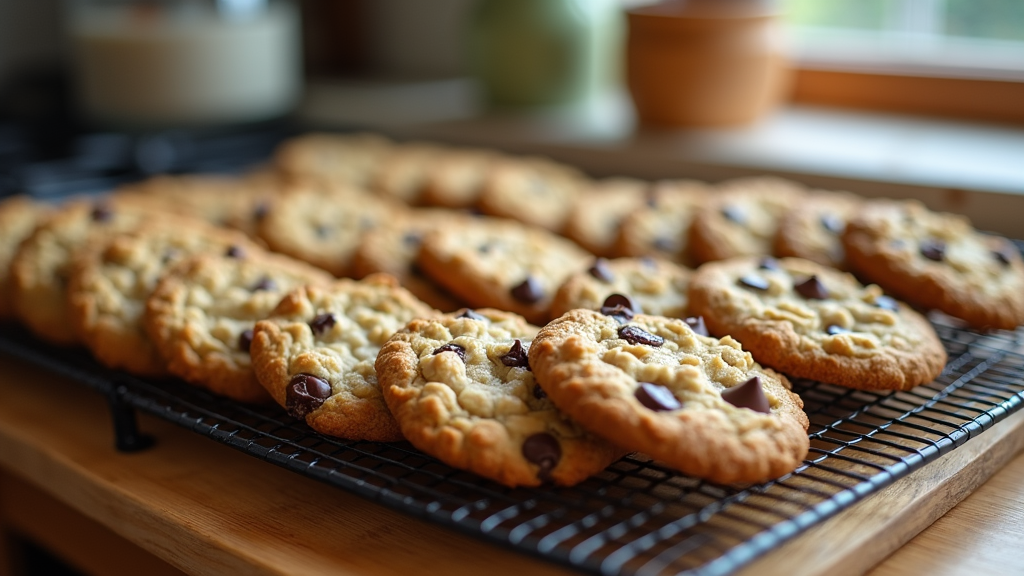 There’s nothing like pulling a tray of fresh, warm cookies from the oven. The smell, the taste, and that perfect texture is hard to beat. Baking cookies at home is pretty simple, but a few tricks can help you nail them every time. Even if you’ve had a cookie flop or two in the past, following a clear process can bump your cookies up to bakery-level good.
There’s nothing like pulling a tray of fresh, warm cookies from the oven. The smell, the taste, and that perfect texture is hard to beat. Baking cookies at home is pretty simple, but a few tricks can help you nail them every time. Even if you’ve had a cookie flop or two in the past, following a clear process can bump your cookies up to bakery-level good.
I’m laying out a step-by-step guide for making perfect cookies, no matter your experience in the kitchen. This covers everything from picking the right ingredients, mixing the dough, actually baking, to storing your cookies so they stay fresh longer. Whether you’re after chewy chocolate chip cookies or crave a crispy edge, this guide helps you get there with confidence.
Step 1: Gather the Right Ingredients
Starting with the right ingredients is super important for a reliable cookie recipe. Cookie basics include flour, sugar, butter, eggs, and leavening (like baking soda or baking powder). The quality and temperature of what you use influence the outcome a lot. If you’re curious about using glutenfree flour or vegan substitutes, make sure to follow a recipe that’s developed for those swaps, as results may differ.
Ingredients Checklist:
- All-purpose flour (measured by spooning, not scooping straight from the bag)
- Granulated sugar and/or brown sugar for flavor and texture
- Unsalted butter (at room temperature for better creaming)
- Eggs (room temperature mixes better)
- Vanilla extract (pure, if possible)
- Baking soda or baking powder (check expiration dates for best results)
- Salt (balances sweetness and flavor)
- Add-ins like chocolate chips, nuts, or dried fruit
Butter is what makes the cookies rich, and using unsalted helps you take control of the saltiness. Bringing eggs and butter to room temp gives a smoother dough, which leads to more even cookies. You can even play around with mix-ins: try a handful of toffee bits, coconut flakes, or even a swirl of peanut butter for something new.
Step 2: Measure Ingredients Properly
Scooping flour straight from the bag can pack it down and give you too much, leading to dense, dry cookies. I always spoon the flour into a measuring cup and level it off with a knife, not the cup’s rim. For sugar and add-ins, a little extra won’t ruin things, but precision helps for consistency. If you ever want to put a number on your ingredients for perfect results, a kitchen scale is your best friend.
Measuring Tips:
- Use dry measuring cups for flour, sugar, and other dry items.
- Use liquid measuring cups for things like milk or melted butter.
- Level dry ingredients with a flat edged knife for accuracy.
- A kitchen scale helps if you want foolproof precision. Especially handy if you bake often.
Salted butter changes the salt balance in your recipe, so stick with unsalted when you can and add your own salt separately. Don’t forget to check your baking soda and baking powder dates—a small detail, but it makes a big impact on your results!
Step 3: Mixing Dough the Right Way
Creaming the butter and sugar properly helps cookies rise, keeps them from spreading too much, and improves texture. I start by beating the butter and sugar together until the mixture is fluffy and light. This adds air and is key for even baking. Cookies are usually better when the mixing process is gentle—don’t try to rush by mixing at high speed the whole time.
Mixing Basics:
- Beat butter and sugars together for 2-3 minutes, scraping down the bowl as needed.
- Add eggs one at a time and mix until just combined.
- Stir in vanilla extract after the eggs.
- In a separate bowl, whisk together dry ingredients (flour, baking soda/powder, salt) before adding to the wet mix.
- Mix dry ingredients into wet just until you don’t see flour; overmixing makes cookies tough.
- Fold in chips, nuts, or extra goodies at the very end to keep the dough tender.
If the dough looks greasy or shiny, it’s probably overmixed. Stop once all the flour disappears in the dough. If you’re working by hand, use a sturdy spatula or wooden spoon to avoid overmixing.
Step 4: Chill the Dough (When Needed)
Some cookie recipes turn out better if you chill the dough before baking, especially those using lots of butter. I usually pop the dough in the fridge for 30 minutes to an hour. This helps cookies hold their shape and develop more complex flavors. Chilling also helps if you live in a warm climate, as it keeps the fat from melting too quickly in the oven.
Why Chill?
- Slows down spreading during baking
- Let’s flavors get deeper
- Makes dough easier to scoop and roll for uniform sized cookies
Not every recipe needs chilling, but it’s worth considering for thicker, chewier cookies or cutout shapes. If you’re pressed for time but want the benefits of chilling, freeze your dough balls for fifteen minutes instead of refrigerating.
Step 5: Scoop Evenly and Prep for Baking
Uniform cookies bake better. I use a cookie scoop or a rounded tablespoon to measure out the dough. For tray prep, line it with parchment paper or a silicone mat for easy cleanup and to prevent sticking. For cutout cookies, lightly flour the surface to avoid too much sticking and to get those sharp edges looking great.
Baking Sheet & Placement Tips:
- Space dough balls about 2 inches apart; cookies spread as they bake
- Press add-ons (like extra chips or sprinkles) onto the tops for picture-perfect cookies
- Turn the tray halfway through baking for even browning, especially if your oven has hot spots
Using cold baking sheets can slow spreading, so start fresh or let trays cool between batches. If you don’t have multiple trays, run your tray under cool water between batches to bring the temperature down fast.
Step 6: Bake at the Right Temperature
Most classic cookie recipes bake at 350°F (175°C), but be sure to follow your specific recipe. A preheated oven is super important. Putting dough into an oven still heating up changes the outcome, making cookies spread unevenly. Baking only one tray at a time on a middle rack is a good way to get even airflow and color.
How to Know When Cookies Are Done:
- Edges are golden brown and bottoms look set
- Centers might look a touch underdone; they finish setting as they cool
- Use a timer, but trust your eyes for the last minute or two
Tweaking the bake time by just a minute or two can turn cookies from chewy to crispy, so watch closely the first time with a new recipe. If you want to experiment, try taking one cookie out a minute early to test which texture you like best.
Step 7: Cool and Enjoy
Cookies firm up a lot as they cool. Let them rest on the baking sheet for 3-5 minutes before moving to a wire rack to finish cooling completely. This avoids overbaking and keeps the bottoms from getting soggy. Pro tip: If you like slightly gooey cookies, tuck a few aside to cool just slightly and eat warm. The rest will be perfect for dunking in milk or coffee later.
Use a thin spatula to lift cookies off the tray once they’re stable. When cool, enjoy a fresh cookie; this is when the texture and flavor really shine.
Common Cookie Questions & Troubleshooting
Why Did My Cookies Spread Too Much?
- Butter may have been too soft or melted
- Dough wasn’t chilled enough
- Too little flour (try measuring with a scale)
Why Are My Cookies Flat?
- Expired baking powder or baking soda
- Not enough creaming during mixing
- Overmixing the dough develops gluten, making cookies tough
Why Are My Cookies Dry or Crumbly?
- Baked too long
- Too much flour or not enough fat
- Oven runs hotter than the dial says—try using an oven thermometer
Storing and Keeping Cookies Fresh
Once baked, cookies stay best in an airtight container at room temperature. Adding a slice of bread keeps cookies softer longer; the bread will dry out while keeping the cookies moist. If you want to keep them beyond a few days, most baked cookies freeze really well. Cool them completely before freezing in a single layer, then stack with wax paper or parchment between to avoid sticking. You can also freeze cookie dough balls for quick, fresh baked cookies anytime—just add a minute or two to the bake time when baking from frozen.
Storage Tips:
- Room temp: up to a week in an airtight container
- Freezer: up to 3 months in a zip Topp bag, well-sealed
- Dough: freeze scooped raw dough and bake from frozen, adjusting time as needed
Final Thoughts & Next Cookie Batch
Baking cookies should feel fun, not intimidating. Getting that warm, gooey or crispy bite is all about following a few basic steps, practicing your measuring and mixing, and tweaking the process to fit your favorite flavor or texture. If you’re curious about more baking tips and tricks, check out King Arthur Baking’s blog for loads of inspiration and trusted recipes. Happy baking!
Your Cookie Game Plan:
- Pick a recipe that sounds good for your cravings.
- Measure ingredients carefully and use quality add-ins.
- Don’t skip chilling the dough if recommended; it really helps!
- Bake a test cookie or two before doing the whole batch. That way you can adjust oven time and temperature if needed.
Got a go-to cookie style or want to share what you’ve baked? Drop your favorites in the comments. And remember: sometimes the best kitchen moments come from a little trial, error, and having fun along the way. Keep baking—the perfect cookie is just a batch away!
